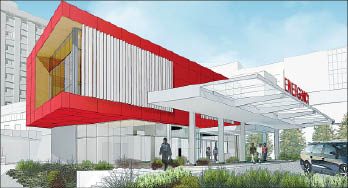Health care isn't recession proof, faces challenges

Tough economic times have tapped on the shoulder of the region's health care sector this year, an industry that in past recessions held steady. The destabilizing impact of the struggling economy is expected to carry into 2012.
Industry leaders anticipate more government reductions in health care payments. They've also seen some decline in patient volumes, attributed at least in part to people putting off elective procedures or losing insurance benefits.
"When the recession first hit, there were a lot of people talking about health care being a bit recession proof, and I think over time we've proven that is not the case," says Steve Duvoisin, CEO of Spokane-based Inland Imaging LLC, which employs more than 550 people in Spokane.
He adds, "Especially with the higher deductible plans, and more employees paying a bigger portion of their health care costs, you see more people deciding not to have elective surgery."
Some positive signs have emerged, though. Providence Health & Services, owner of Providence Health Care Eastern Washington ministries including Sacred Heart Medical Center and Holy Family Hospital, announced this month its plans to consolidate and relocate its billing functions in Spokane that is expected to add more than 150 new jobs here.
Sacred Heart also started construction for a new emergency department this fall, and its ER services are in high demand, says Mike Wilson, interim chief executive for Providence Health in Spokane. Additionally, he says Providence is considering adding clinics around Spokane.
"We're seeing some growth," he adds. "We're working diligently to make sure the cost of care is managed efficiently."
However, he says a major impact is expected from proposed state cuts toward paying costs of the medically indigent and workers who don't have employer-sponsored health insurance. In mid-November, Providence Health Care in Spokane announced an anticipated $61 million budget shortfall and called for voluntary layoffs. The organization is offering severance pay and cash bonuses to employees who opt to leave, though it wasn't clear as of early December how many people would be leaving.
A majority of the shortfall has to do with already enacted reductions in state budgets and in federal spending on Medicare or support for state-based programs, Wilson says. It also stems in part from a reduction of more than 3 percent "in overall utilization of our hospital service," he says.
At the same time, he says Sacred Heart next year expects about 0.5 percent to 1 percent growth in overall patient volume, which parallels expected population growth here.
William Gilbert, CEO at Deaconess Medical Center, also cites proposed state legislative cuts as having significant impacts for health care going into next year.
"As best we can tell, it's going to be a continuation of government reductions in payments for health care," Gilbert says. "Much like in 2011, we would expect that the legislators will look at health care as a big target. That is increasingly putting the most vulnerable at risk."
Deaconess, Valley Hospital, and Rockwood Clinic, all owned by Franklin, Tenn.-based Community Health Systems Inc., is integrating services under its new Rockwood Health System name. Gilbert says that federal health care funding changes are being seen by his organization as constructive, as the government moves toward increasing funding under Medicare to hospitals that are considered high performing.
"The federal government is incentivizing us to improve quality and patient perception of service," Gilbert says. "That continues to ramp up in 2012 and '13."
However, challenges emerge as people expect the best health care, he adds.
"The expectation for you, me, and our families is they get nothing but the best. However, this is in conflict with our economic situation, the reduction in payments from the state, and it's going to be a challenge for us under health care reform."
Duvoisin, who says Inland Imaging is set on remaining an independent private medical group, adds that he's watched the many changes that have already occurred the past two years with several physician groups aligning with hospitals. He expects that trend to continue.
He adds, "We're entering the bumpy part of the rapids, so the next three to five years should be really interesting."
Related Articles




